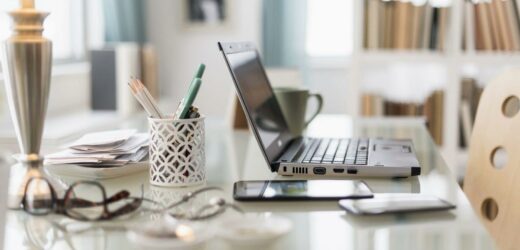and
Finding working from home difficult right now? Maybe it’s time to refresh your at-home workspace – and we’ve crafted an expert guide to decluttering and organising your desk.
With working from home continuing to be a reality for many workers and even some taking the time to travel while they work, many of us have had to create workspaces in areas of our home that were designed for totally different purposes.
Although there was a reported rise in productivity when working at home was first introduced at the start of the pandemic, many people are now finding it more challenging. As workplaces continue to experiment with hybrid working, it’s really important that our WFH spaces continue to inspire us.
Whether you’re working from your kitchen table or you have been able to create an at-home office, it’s important to refresh your space. “Having an organised desk can really impact your mental state,” says Lizzie Grant, a productivity and organisation expert. “Having lots of disorganised stimuli around you takes your focus away from your work.”
As a professional organiser, Lizzie has spent plenty of time organising desk spaces over the last 18 months and she has figured out a variety of ways you can boost your productivity and feel calmer at your workspace. Here are four ways.
Practise your decision-making
The first step to declutter your workspace is deciding exactly what you need to keep and what you can afford to remove. Lizzie recommends taking everything from your desk out of its usual space and laying it out, so you can see it before deciding what you do and don’t need. “You don’t need to do it all at once,” she adds. “You could do a category per day or even per week if you’re short on time.”
“Decide what you need and what you use everyday and limit yourself by the number of each item you want to keep before you start organising,” Lizzie advises.
If you find decluttering and organising difficult, Lizzie suggests starting with the easiest category. “Often the easiest category to start with when it comes to office spaces is stationery,” she says, explaining that people often have too much stationery. “You also probably won’t have much of an emotional connection to stationery so it shouldn’t be too hard to make practical decisions. This will help you practise your decision-making as you move onto more difficult items.”
Take time with your paperwork
People are often intimidated by organising paperwork but it’s not necessarily as difficult as you might think. “Don’t worry about getting rid of something you might need in the future because there are almost always solutions to this,” Lizzie says.
To start organising your paperwork, Lizzie suggests creating three categories: file, action and waiting on an action. With the items you want to file and keep, Lizzie advises keeping the paperwork you check most days in a tray on your desk. For paperwork that you don’t check frequently, put it in storage or digitise it.
“I also recommend having a tray on your desk for paperwork that you need to action or that you’re waiting for somebody else to action,” Lizzie says. If you can see the paperwork that needs dealing with, you’re more likely to sort it out quickly, and then once that’s done you can either file or get rid of it.
“Make sure to shred any confidential paperwork before recycling it,” Lizzie advises.
Organise your desk by frequency of use
Lizzie says that it’s OK to have some things laid out on your desk, but only the items that you’re using on at least a daily basis. “If you have a lot of items that you need but you’re not using that regularly, it’s worth investing in drawers to go under your desk or a storage box where you can store these things and keep them nearby,” she says.
Try to organise your desk in a way that makes sense to you. For example, if you’re usually reaching for your notepad at the same time you’re reaching for your pens, keep these things together. By only keeping the items that you keep daily on display, you should minimise clutter easily.
“It’s fine to have a few personal, decorative things on your desk too if they make you feel good but it’s easy for that to get out of control,” Lizzie adds. She suggests choosing two or three items like a framed photo, a plant and a candle. If you can’t decide which items to display, commit to rotating them and keeping the others in storage when they’re not being used.
Put a tidying routine into place
To ensure your productivity levels stay high, it’s essential to maintain a tidy desk. “Get into the habit of tidying for a short period of time either before you start work or after you finish,” Lizzie suggests.
It’s also worth only buying storage products after you’ve worked at home for at least a few months, so you know what your storage needs are. “If you work from your dining room table or don’t have a specific office, it can be really useful to buy a simple storage box that you can store your day-to-day items in and put underneath your couch or somewhere out of sight when you’re not working to encourage work-life balance,” Lizzie says.
Images: Getty
Source: Read Full Article


